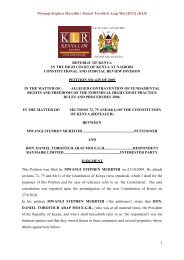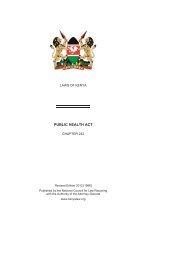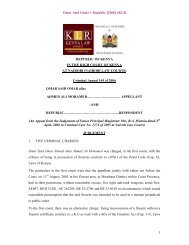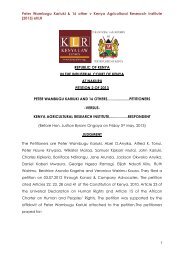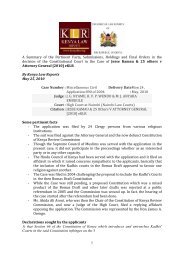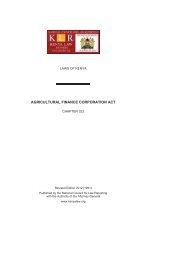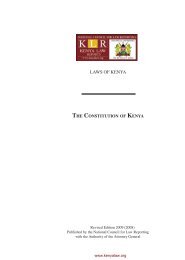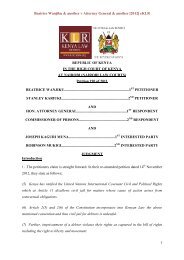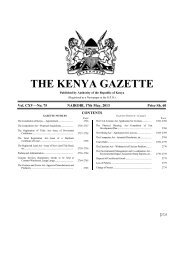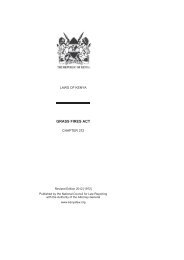Bench Bulletin - Issue 12 - Kenya Law Reports
Bench Bulletin - Issue 12 - Kenya Law Reports
Bench Bulletin - Issue 12 - Kenya Law Reports
Create successful ePaper yourself
Turn your PDF publications into a flip-book with our unique Google optimized e-Paper software.
KENYA LAW REPORTS<br />
BENCH BULLETIN<br />
FROM THE COURTS — COURT OF APPEAL<br />
The respondent’s advocate argued that the appellant had not denied the existence of the duty of care. He contended<br />
that the results of the lab analysis produced in evidence to prove injury were sufficient as they had not challenged by<br />
the appellant at the trial despite being represented by counsel. The certificate produced the <strong>Kenya</strong> Bureau of Standards<br />
stated that the contents of the bottle were unfit for human consumption and that even the shock experienced by the<br />
respondent amounted to injury. The appellant’s advocate maintained that since the respondent bought three bottles<br />
in the same batch, and in the process of taking the second bottle he noted impurities in it and in the third bottle, the<br />
duty extended to all the bottles manufactured in the same batch by the appellant.<br />
Held:<br />
1. The unopened bottle, which was examined by <strong>Kenya</strong> Bureau of Standards, contained the same impurities as the<br />
opened bottle which was partly consumed by the respondent. The appellant’s witness had acknowledged to the court<br />
that if the bottles were of the same batch, it was reasonable to assume that if the opened bottle had impurities, the<br />
unopened one too had the same impurities as was witnessed by the respondent. This in effect meant that what the<br />
respondent consumed and what was in the unopened bottle which was examined were the same and only in different<br />
containers. In that scenario, there was a clear nexus between the bottle manufactured by the appellant and respondent.<br />
There was therefore no proper reason to interfere with the concurrent finding of the two courts below on that aspect<br />
which was a finding on fact based on cogent reasoning.<br />
2. The appellant had special knowledge of its system of production and could have very easily produced evidence<br />
to show that the unopened bottle, although it could be seen to have what looked like similar impurities in the half<br />
consumed bottle, was nonetheless, a separate bottle not produced together with the offending bottle.<br />
3. The results by the <strong>Kenya</strong> Bureau of Standards were not vitiated for failure to obtain proper authority before<br />
conducting the examination. The appellant who had the report at the hearing of the case did challenge the legality of<br />
the report by the Bureau of Standards in the trial court. Even if it had been proved that it was improperly obtained,<br />
that alone would have probably only affected its value and not its admissibility.<br />
4. The best course would have been to proceed under that Act as the beer was within the food bracket. But the report<br />
that was made by <strong>Kenya</strong> Bureau of Standards, a body empowered by law to ensure proper standards of products released<br />
into the market, which would include beers and several other products, could be ignored. It categorically stated that<br />
the beer did not meet the standard required meaning it was not fit for human consumption. The appellant did not do<br />
anything to demonstrate that the beer was wholesome and fit for human consumption unlike the results of the <strong>Kenya</strong><br />
Bureau of Standards indicated. The accepted evidence was that the appellant consumed beer which had impurities and<br />
which was unfit for human consumption. It did not matter where the test was carried out and it did not matter under<br />
which law the examination was done so long as the report has dealt with the essential aspects of the matter and the<br />
same test was admitted at the trial by a competent court of law.<br />
5. In order to hold a defendant liable to the plaintiff the plaintiff has to prove that the defendant owes him a duty of<br />
care; that that duty has been breached and that as a result of that breach, the plaintiff has suffered injury (Donoghue<br />
v Stevenson). In the instant case the respondent consumed one and a half bottles from the batch and fell sick. There<br />
were documents produced in court to prove the same and those documents were not challenged on their contents.<br />
Whether the suffering was minor resulting from shock of having drank beer that had impurities or real resulting into<br />
vomiting and diarrhoea as the respondent said, it all boiled down to the fact that those were injuries.<br />
6. [Nyamu J.A. dissenting] The unused beer bottle was never consumed and the half consumed beer was never analysed<br />
and therefore the linkage of its contents to the injury was by an inference not by actual factual proof of negligence.<br />
7. [Nyamu J.A. dissenting] The neighbourhood principle, and the duty of care owed, has been substantially influenced<br />
by the scientific dimension and medical advancement in the last 80 years. In some cases depending on the facts, the<br />
principle has been restricted in its application or expanded by the ever changing frontiers of science. Liability at this<br />
time and age must take this into account. Indeed the manufacturers’ liability to the ultimate consumer should be<br />
determined on the basis of the facts and not a matter of routine. The application of the Donoghue v Stevenson ratio to<br />
the special facts on this case was patently erroneous.<br />
Appeal dismissed.<br />
Advocates<br />
1. Mr. Lutta for the Appellant<br />
2. Mr. Ochieng’ Ogutu for the Respondent<br />
54<br />
<strong>Issue</strong> <strong>12</strong>: April-June 2010



